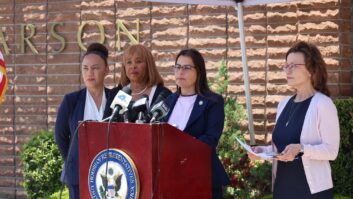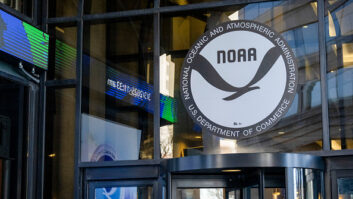Soon after the world changed forever on 9-11-2001, Guy Wire exposed the EAS system for what it was: A woefully inefficient warmed over relic of the Cold War riddled with weak links that did little more than augment warning systems in areas vulnerable to hurricanes and tornadoes. When we need timely and valuable emergency information in most areas of the nation, EAS is rarely activated. Other resources scramble to fill that role and EAS too often falls into silent irrelevance. Except for testing.
Instead of pushing for real fixes to an arcane system in a rapidly evolving digital but dangerous age, what the FCC had been doggedly focusing on the most with EAS was the maintenance of testing and logging requirements and the threat of monetary fines for stations not fully in compliance.
Defending the sacred cow
A few EAS operatives responded to my wood-shedding of their sacred cow mostly with excuses for why it was not activated on 9-11 or during recent big West Coast earthquakes. They said a national alert on 9-11 was not issued because the “normal channels” of broadcast news were all up and running for the president or the feds to use “if necessary.”
Never mind that terrorists had launched direct devastating attacks on New York City and Washington. If ever there was a time for EAS to validate its perceived role as a resource for critical emergency information, especially for those cities, this was it. Activating a national alert to inform a shell-shocked and apprehensive nation during the first few hours would now seem to have been most appropriate.
EAS proponents and apologists have long maintained the system should only be used for advance warning of “long-fused” emergencies. This rationale exposes their outdated and limited view of how governmental agencies could and should manage the business of emergencies and threats to public safety.
Events of 9-11 changed everything. In an era of heightened anxiety and instant communications with scores of media outlets breaking news minute by minute, the public expects the government at all levels to be more engaged and responsive when emergencies threaten and strike.
Big changes on the way
I guess these guys were too far inside the EAS forest to see the need for new growth. Fortunately some key government folks charged with emergency alerting and management appear to have agreed with my analysis and are calling for a complete overhaul of the EAS system. According to the lead article in Radio World of Feb. 1, “Sources at the FCC say the commission will soon begin considering recommendations for a new public warning system to enhance or possibly replace EAS.”
Thankfully the aftermath of 9-11, along with recent high-profile child abduction cases, has engendered some new thinking about how EAS can be used as a more effective tool during terrorist attacks, civil disturbances and kidnappings. Serious emergencies that impact small and large areas alike come from more than just Mother Nature or ICBMs.
Amber to the rescue
The Elizabeth Smart case in Utah prompted federal legislation that helped standardize the Amber Alert program in early 2003. Including it within the EAS system has shed some positive light back on the ability of EAS to deliver something of value. What could be more precious and worthy than helping save the life of a child being kidnapped? The CAE (Child Abduction Emergency) activation of EAS as a part of the Amber program has been directly credited for saving the lives of a number of children over the past year.
Many station jocks and programmers have gained a new measure of respect for their EAS box and its expanded role in delivering results. Every radio station in America can take pride in being part of the Amber program and make sure they quickly rebroadcast CAE alerts and related information on their stations.
Local police and the other civil authorities responsible for initiating Amber Alerts must do all they can to quickly identify and qualify missing children cases for Amber and transmit the information out over the local EAS and highway signage systems. Time is always so fleeting in these kinds of cases. If only they had acted more quickly in the recent tragedy of Carlie Brucia in Florida.
New groups with new ideas
9-11 completely altered the way our government now evaluates and responds to emergencies. FEMA is no longer the primary agency charged with emergency management. The newly created Department of Homeland Security is quickly stepping in to a new role that will shepherd in the big changes coming for EAS.
Jim Dailey, director of the Office of Homeland Security for the FCC’s Enforcement Bureau, confirms in RW’s article that the commission is now working directly with the DHS to develop the framework for a Notice of Inquiry, soon to be released and eventually a Notice of Proposed Rule Making to change Part 11 of the FCC Rules for EAS.
A federal advisory group working with the FCC on the issue is the MSRC, or Media Security Reliability Council. Its mission is “to prepare a comprehensive national strategy for securing and sustaining broadcast and MVPD facilities throughout the United States during terrorist attacks, natural disasters and all other threats or attacks nationwide.” See www.mediasecurity.org.
In addition to this long-awaited government effort to push forward the dialog for needed changes, a non-profit organization called the Partnership for Public Warning is also tackling the issue. PPW has a Web site outlining its activities and recommendations at www.partnershipforpublicwarning.org
A few more ideas
Since I fired the first volley on this issue right after 9-11, let me throw a few of my own logs on the fire of EAS debate.
I’ve always marveled at how EAS is made voluntary for broadcasters’ participation for the real emergencies that do happen, but mandatory for those that have never happened. How about making the transmission of major emergency alerts mandatory across the board so the industry can pay it proper respect and fulfill its role as servant of the public interest and welfare? Include ALL licensed and regulated radio and TV outlets, whether they are terrestrial, satellite or cable.
The PEP system is charged with disseminating only national alerts. It may have already morphed into a white elephant without ever being used. Entrusting a handful of AM stations to relay critical information from the president to the entire nation during a real national emergency is a lame leftover right out of the Conelrad playbook.
The U.S. is filled with media outlets with national distribution that could easily have direct communications to the White House and other centers of government. Most have tons of redundancy and backup.
Is it even reasonable to expect that ALL of those resources could be rendered useless while the PEP system remained fully functional and viable? I highly doubt it. It’s time to scrap the PEP project and simply redirect and expand the hardened communications channels from the president out to existing mass media networks.
Eliminating weakness
The weakest link in the EAS daisy chain scheme has always been the last link. For real unscheduled EAS activations to reach their intended audiences, local stations run by mostly minimum wage board ops or automation systems are anything but reliable. Many stations still do not trust automatic forwarding via another station, which is often their competitor.
Because they’ve been burned in the past, too many stations choose to be very selective with incoming EAS alerts and do not enable auto-forwarding. The path of emergency information from government agency to the listener must be more seamless.
EAS alerts could be made much more reliable and efficient if the originating local agencies, usually interconnected with 911 centers, transmit alerts directly to as many stations as possible without intervening relay stations. Redundant wired and wireless links are not that expensive to implement and maintain between 911 centers and electronic media outlets in population centers.
Make automatic EAS activation and forwarding of the major emergency warnings and events likely to occur in a local area mandatory. National Weather Service stations should be fully integrated into EAS and their technical needs properly supported. All licensed radio and TV stations should be required to monitor regional NWS stations, except in isolated areas where signals are unavailable.
Requiring only voluntary participation in a system that delivers vital information about life-threatening events just doesn’t make sense. They may as well make paying federal income taxes voluntary.
Harnessing HD Radio
As I suggested back in 2001, the radio industry is quickly moving towards the adoption of new digital transmission standards. The data portion of the HD Radio signal for both AM and FM lends itself beautifully to EAS alert override signaling and switching. Text messaging can augment all EAS alerts. Regular testing could be conducted without necessarily interrupting main channel programming.
The advent of HD Radio gives us a golden opportunity to craft a system that can streamline and dramatically enhance the EAS system. Before any ink dries on the HD/IBOC standards now under construction, EAS should be included as an integral part of the design so receiver manufacturers can incorporate an appropriate delivery protocol in the next generation of HD Radios.
Not the only game in town
Radio and TV are not the only mass-consumer appliances that can convey EAS information. The rapidly expanding universe of electronic gadgets and devices that could deliver EAS alerts include cell phones, Internet-connected computers and PDAs, and potentially even devices like game stations and MP3 players.
Cell phone companies and Internet service providers like AOL and MSN could offer automatic emergency v-mail and e-mail alert services for those in the local areas affected. The Amber system already has such a service available to e-mail subscribers. EAS could easily tap this resource.
These are just a few ideas that could help modernize and elevate EAS as a more effective tool for supporting public safety. It appears the DHS and FCC are inviting many new voices to the emergency alerting standard-setting table to help decide whatever the best and most effective improvements will be for a revised or replacement EAS system. We only hope they don’t behave like most government agencies and take almost forever to adopt vitally needed changes.






